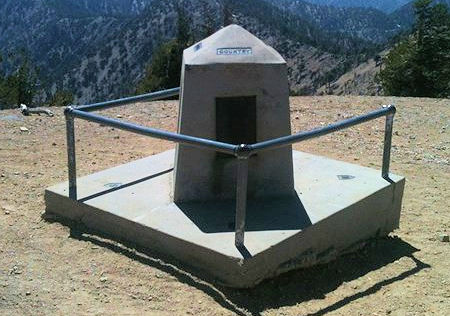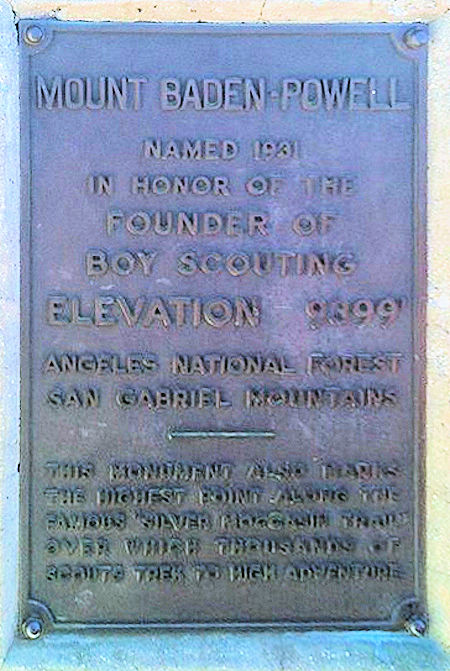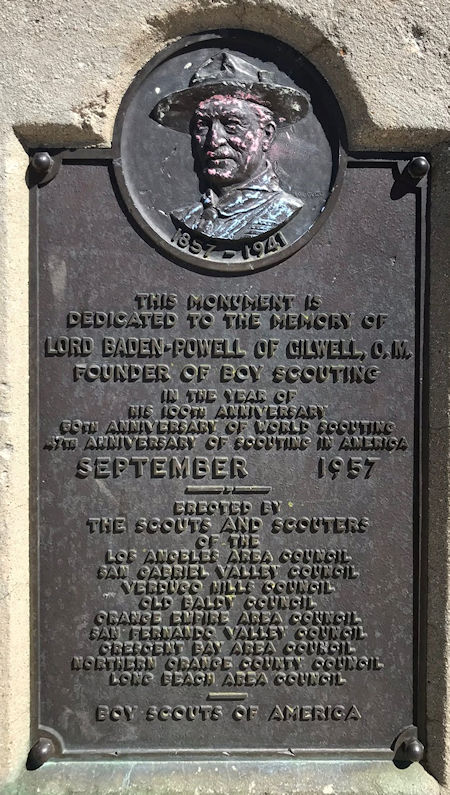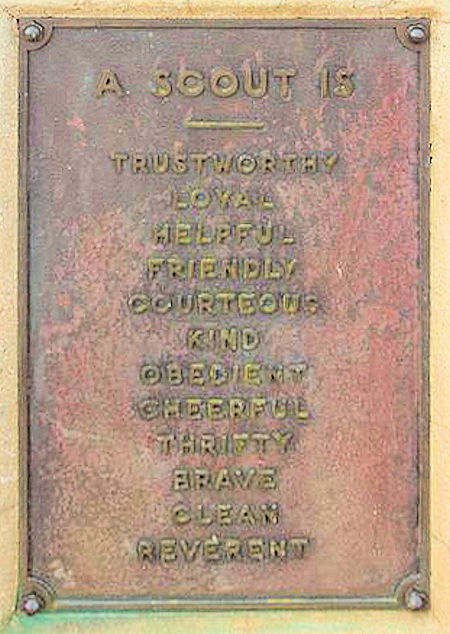
Monument with plaques on top of Mt. Baden-Powell

Mount Baden-Powell Identification Plaque on the Baden-Powell Monument
9399' Mount Baden-Powell is easily reached as a day hike from several road heads. It is also included in the Silver Moccasin Trail hike of the Los Angeles Council, Boy Scouts of America. The peak is named after the founder of the Scouting movement and has a plaque on top. More information here including a printable map and pictures and here and here and here.
I climbed it in August 1956 as part of a Boy Scout group from Los Angeles, CA led by Jim Goldstein on the Silver Moccasin Trail.
The standard route from Vincent Gap to the summit is 8 miles round trip with 2,800-foot elevation gain via the Mount Baden-Powell Trail. This trail and peak honor Lord Baden-Powell, a British Army officer who founded the Boy Scout movement in 1907.
The well-engineered trail, grooved into the side of the mountain by the Civilian Conservation Corps in the mid-1930s, switchbacks up the northeast ridge to the peak.
The peak was once known as North Baldy, before Southern California Boy Scouts lobbied the Forest Service for a name change.
Mount Baden-Powell is the terminus of the scouts' 53-mile Silver Moccasin Trail, a rugged week-long backpack through the San Gabriels. Scouts who complete the long trail earn the Silver Moccasin Award.
The trail follows a moderate, steady grade to the top of the mountain, where there's a monument honoring Lord Baden-Powell.
On the summit, you'll meet those ancient survivors, the limber pines, and be treated to superb views across the Mojave Desert and down into the Iron Fork of the San Gabriel River.
The hike: The trail immediately begins ascending from Vincent Gulch Divide, a gap which separates the upper tributaries of the San Gabriel River to the south from Big Rock Creek to the northwest.
You begin switchbacking southwest through Jeffrey pine and fir. The trail numbers more than three dozen of these switchbacks, but so many beautiful attractions compete for the hiker's attention that it's hard to get an accurate count.
In 1.5 miles, a side trail leads a hundred yards to Lamel Spring, an inviting resting place and the only dependable water en route.
With increased elevation, the switchbacks grow shorter and steeper and the vegetation changes from fir to lodgepole pine. Soon, even the altitude-loving lodgepoles give way to the heartiest of pines, the limber pine. A half-mile from the summit, around 9,000 feet in elevation, the first of these squat, thick-trunked limber pines come into view. Shortly, you'll intersect a side trail to the limber pine forest.
To Limber Pine Forest: A tiny sign points right (southwest) to the limber pine stand, 1/8 mile. These wind-loving, subalpine dwellers are one of the few living things that can cope with the rarefied atmosphere. Pinus flexilis, botanists call the species, for its long, droopy, flexible branches. They bow and scrape like hyper extended dancers and appear to gather all their nourishment from the wind.
Back on the main trail, a few more switchbacks bring you atop the ridge where Mount Baldy can be glimpsed. You walk along the barren crest and intersect the Pacific Crest Trail. PCT swoops off to Little Jimmy Spring.
You continue past the limber pines to the summit. A concrete monument pays homage to Lord Baden-Powell. Enjoy the superb view out across the Mojave to the southern Sierra and east to Baldy, San Gorgonio and San Jacinto.

Baden Powell Monument Dedication Plaque

Scout Oath Plaque on the Baden-Powell Monument